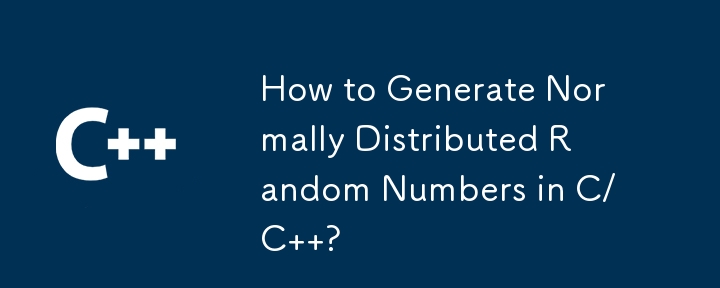Home >Backend Development >C++ >How to Generate Normally Distributed Random Numbers in C/C ?
How to Generate Normally Distributed Random Numbers in C/C ?
- Susan SarandonOriginal
- 2024-11-27 16:51:12367browse

Generating Random Numbers Using Normal Distribution in C/C
The need to generate random numbers following a normal distribution often arises in various programming applications. In C/C , there are several techniques you can employ to achieve this.
One widely adopted approach is the Box-Muller transform. This method involves generating two independent uniform random numbers and transforming them using a mathematical formula to obtain normally distributed values. The Box-Muller transform is mathematically rigorous and produces accurate results.
Here's how to implement the Box-Muller transform in C/C :
#include <random>
#include <cmath>
// Generate a random number following a Gaussian distribution
double normal_rand() {
static double z1;
static bool ready = false;
// If z1 is not ready, generate two uniform random numbers
if (!ready) {
double u1 = std::uniform_real_distribution<double>(0, 1)();
double u2 = std::uniform_real_distribution<double>(0, 1)();
z1 = std::sqrt(-2 * std::log(u1)) * std::cos(2 * M_PI * u2);
ready = true;
}
// Return z1 and mark it as used
ready = false;
return z1;
}
In the above example, std::uniform_real_distribution generates uniform random numbers, while std::sqrt and std::cos perform the necessary mathematical transformations.
Utilizing the Box-Muller transform provides a straightforward and reliable way to generate random numbers following a normal distribution in C/C . By employing this technique, programmers can avoid the use of external libraries like Boost and leverage the standard C library's functionality.
The above is the detailed content of How to Generate Normally Distributed Random Numbers in C/C ?. For more information, please follow other related articles on the PHP Chinese website!
Related articles
See more- C++ compilation error: A header file is referenced multiple times, how to solve it?
- C++ compilation error: wrong function parameters, how to fix it?
- C++ error: The constructor must be declared in the public area, how to deal with it?
- Process management and thread synchronization in C++
- How to deal with data splitting problems in C++ development

